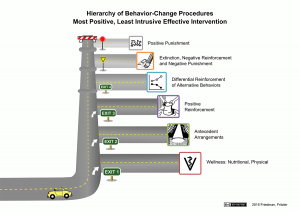Goals
For me the main goal of training is ensuring that your dog masters everyday situations that are stressful for them – it may be walking past other dogs on a narrow sidewalk, passing cyclists, rumbling buses, grooming or even something as mundane (to us!) as a staircase. After all, we want our dogs to enjoy their life and we want to enjoy our life with them. Whether you’ve just adopted a dog from a shelter, you want to set your puppy up for success, or you have been struggling with an unwanted behavior for a long time – I can help. We will change your dog’s behavior using science-based, humane methods, always keeping in mind their welfare (and your quality of life too!). If you’re interested in details, keep reading.
I adhere to the Hierarchy of Procedures for Humane and Effective Practice. That means that we will first check if the unwanted behavior is related to your dog’s physical condition (health, nutrition, exercise) or if something in the dog’s environment (antecedent arrangement) is causing trouble. Dogs – just like us – need to feel well in order to be able to learn.
Step 1: Assessment
Behavior is a beautiful thing. It allows us to react to our environment in order to achieve our goals. Every behavior has a function – that is the foundation of applied behavior analysis. First, we will try to figure out what makes your dog behave the way they do with the help of the questionnaire you filled out and information you provided during our first consultation.
Step 2: Management
Once we understand your dog’s behavior, the next step is management. I will help you change the environment (the antecedent arrangement), so that your dog doesn’t have the chance to perform unwanted behaviors anymore or that they perform it less often.
You might think this is cheating, but in reality without good management it’s really hard to achieve behavior change.
Step 3: Behavior modification
Once we know what drives your dog’s behavior and have management measures in place to prevent it from happening, we can proceed with behavior modification. We will set up situations in which your dog can behave correctly1 and reward that behavior (our primary tool is positive reinforcement). We will strengthen the correct response in small approximations, until they can use it under the problematic circumstances that we identified during assessment.
Is that all?
Sounds too simple to be true? Well, it is more complicated than that, which is why working with a dog trainer is a good idea. Check out the resources I recommend if you want to learn more about modern training methods.
And don’t worry, I will be with you every step of the way. I will teach you all that you need to know in order to be successful:
-
- how to read canine body language, so that you can get out of the problematic situation before your dog reacts “wrong”,
- how to apply learning theory to teach your dog new, “correct” behaviors, and
- how to use your own body language to support your dog, for example shield them from a trigger or communicate clearly that you mean no harm.
You can ask me questions at any time. If you’re uncomfortable with a procedure I suggested, we will look for another solution. We are in this together.
This will not happen
We will NOT:
-
- set your dog up to fail and then punish them for their mistakes,
- use aversive tools, such as e-collars, choke or prong collars,
- use leash corrections,
- use threatening body language, or
- deprive your dog of food or social contact in order to increase motivation.



